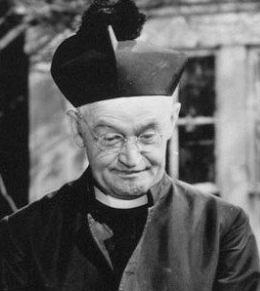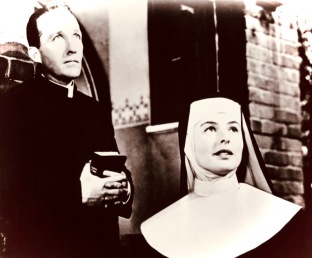TopBilled:
GOING MY WAY is not what I expected. It’s very slow in spots, but that is not a negative criticism…the slowness allows us to absorb the characters and their situations. Bing Crosby and Barry Fitzgerald have a field day together, and it’s no wonder Paramount teamed them in two more unrelated films. Interestingly, Fitzgerald was nominated as supporting actor and best actor (something that would not be allowed later by the Academy).
In the reviews I have read, I’ve never seen anyone call this a religious musical but that’s definitely what I would label it. It has more music than the sequel, and sometimes the plot comes to a halt so we can hear characters sing. Not just Crosby, but other ones too– like the woman who gets her own scene performing from Bizet’s ‘Carmen’. It lends to the overall entertainment value, but it does take us away from the main story line, which is what’s happening at the church.
The last section choked me up more than I expected it would, where they bring the old Irish woman in to be reunited with her son. Leo McCarey and his cast were pouring it on, but it works– because we see how one man (Father O’Malley) helped change all their lives in a very short amount of time. The choir boys, who seemed derivative of the Dead End kids; the elder priest; the priest at the nearby parish; the young girl and her new husband and father-in-law; the opera singer; and O’Malley himself– they’re all part of a kaleidoscope of faith.
*****
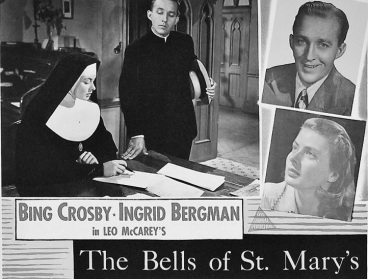
I think I like THE BELLS OF ST. MARY’S a bit better than GOING MY WAY. The contrast in acting styles between Bing Crosby and Ingrid Bergman really underscores the fact these are two very different people trying to carry out the Lord’s work. The filmmakers seem to have refined the formula they established in the first film. Again, Crosby’s character has to work his way in and challenge how things have always been done; and again, he builds personal relationships with the children and a couple in love (in this instance, a school girl’s separated parents).
Similar to how the church was struggling in the earlier story, it’s the school that is struggling in the sequel. Plus we have another money-obsessed villain in the form of Henry Travers. And while the various characters experience their ups and downs and individual crises of faith, the very existence of the institution itself is called into question.
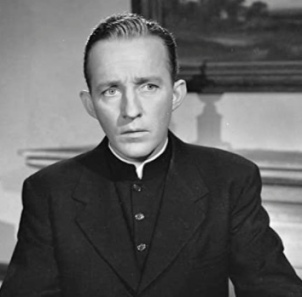
This all comes full-circle when Bergman’s character is diagnosed with tuberculosis and must leave at the end, reminiscent of how Crosby left before.
They could have gone right on making a series of these films, with the Father O’Malley character bouncing from place to place like Maisie Ravier. But maybe it’s good they stopped after the second one, because it leaves us wanting more and arriving at our own conclusions about the fate of each person and where their faith took them.
***
Jlewis:

GOING MY WAY pulled an impressive stunt in 1944 by earning both the biggest box office gross that year and the coveted Best Picture Oscar, while starring that same year’s most popular actor according to the annual Quigley lists, Bing Crosby, and he, in turn, won the Best Actor Oscar. This stunt would repeat exactly five decades later with FORREST GUMP and Tom Hanks. Both films were bankrolled by the same studio: Paramount.
Consequently most movie fans and critics tend to view the two equally: “good” but hardly “great” and likely to get on most (but certainly not all) viewers’ nerves when seen for a second time. You either love them or loathe them since their overall tone, as well as the lead stars’ personalities, are so laid back and easy going.

The line in the 1994 film of “life is like a box of chocolate” is as much a tipping point for many as that ‘44 song “Swinging on a Star,” which was one of those huge hits on the Billboard charts that you could not avoid in the forties…much like “Doggie in the Window,” “I’m Henry VIII, I Am,” “Disco Duck,” “Don’t Worry, Be Happy” and “The Macarena” in the subsequent six decades of the 20th century. Then again, I loved the monkeys singing it as they were a-swingin’ on cardboard stars in a vintage Jerry Fairbanks/Paramount “Speaking of Animals” short film made a bit later.
I have to bring up Jack Benny here briefly. On April 4, 1948, there was a deliriously funny radio episode on his Lucky Strikes Program in which, after “borrowing” Ronald Colman’s Oscar for A DOUBLE LIFE in the previous week’s show and losing it in a gun held stick-up, Benny tries to compensate by “borrowing” (again) Crosby’s statuette won for GOING MY WAY three years earlier. Apparently Crosby, the featured guest star that episode, wasn’t terribly concerned about its welfare and was more than willing to lend it to Benny. That is, after one of his sons was done using it a bathtub stopper!

I think that sums up the appeal of Crosby in a nutshell. He was just so “oh hum” about life. This is why he dominated the Hollywood box office in the forties. Many Americans were in constant stress with war and other struggles and he offered welcome home steadiness. (Also why a certain holiday song of his never left the charts for a decade, since it too offered a few minutes of tranquility during times of constant stress.) I think this explains the later appeal of Tom Hanks as well since he too is an Everyman type whom many of us instantly feel at ease with, like the most trusted and comforting family member.
Basic plot for GOING MY WAY: Father O’Malley (Crosby) comes to St. Dominic’s as “fresh blood” to oversee aging set-in-his-ways Father Fitzgibbon, played by lovable Barry Fitzgerald. Initially there is a personality clash between the two priests who are separated by three decades in age and experience.
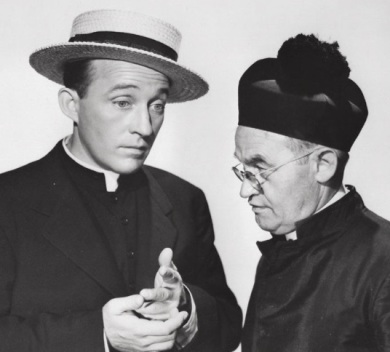
At one point, Fitzgibbon gets so upset learning of O’Malley’s possible replacement of himself that he over-reacts with an attempted runaway scene worthy of any hot blooded teenager. Yet they do become buddies in the end with the junior priest even reuniting the older gent with his mommy, who is well into her nineties but still able to visit all the way from Ireland.
Also an Oscar winner for this film, most viewers may be more familiar with Barry Fitzgerald in other films like THE QUIET MAN or being familiar with his voice, lampooned in cartoons featuring various stock Irish characters (one example being the Porky Pig toon WEARING OF THE GRIN years later).
Before the emotional happy scene towards the end, there are some episodic incidents that include city boys (including Carl “Alfalfa” Switzer of earlier Our Gang fame) getting organized into a musical group (of course!) and with a professional soprano (Risë Stevens of the Metropolitan Opera) joining them later on a rendition of the title tune of the picture; this makes it a partial musical of sorts allowing some Bing-sing.

A stolen turkey is sadly fated to become Fitzgibbon’s dinner and, while I am guessing no critters were killed in its making, this is nonetheless a fate shared with the last surviving rooster in the Civil War torn Atlanta of a previous Best Picture (a foul time for all fowl). There is also sudden building damage from a fire. Then there is a wayward teen girl named Carol (Jean Heather) who gets assistance from the young priest and inevitably marries a soon to depart soldier Ted Haines Junior (James Brown), son of Gene Lockhart’s hypercritical Ted Haines senior, instead of just getting a job at Lockheed.
Frank McHugh has a likable supporting role as another priest playing third party to the relationship, along with your usual salt-of-the-earth housekeeper Mrs. Carmody (Eily Malyon). Additional cast members of note doing their bit include Porter Hall, then famous musical talent Fortunio Bonanova and William Frawley.
Leo McCarey, a veteran of many classic comedies like THE AWFUL TRUTH along with a few serious dramas previously, does a good job with his direction, preventing this from being a totally icky affair. It almost becomes one…but not quite. You can not help liking the cast who seem to genuinely care about each other.
***

Although MRS. MINIVER spawned a sequel eight years after its release, GOING MY WAY beat it as far as Best Picture sequel-ing goes. Only took just over a year for director and lead star to reunite (since the latter film’s script was actually written first), but this time with another studio: RKO Radio. (Seven other Best Pictures also had sequels, with one of these also winning a Best Picture Oscar even though THE GODFATHER II was partly a prequel.)
I had seen GOING MY WAY multiple times but surprisingly THE BELLS OF ST. MARY’S only once before. Kinda realize why…it is a much more predictable outing. Yet all of the Bing Crosby films have charm for me, even if I found him a trifle more disappointing here than his other roles.

Setting is different: St.Mary’s has a school not unlike some we have profiled last month. Much nicer and cozier place to attend. This gives RKO the excuse to use all new sets (or recycled from unrelated projects) and not have to bother with other cast members of the previous film apart from Crosby.
In THE GODFATHER (a Paramount production like GOING MY WAY), THE BELLS OF ST. MARY’S gets referenced in a key scene with Kay asking Michael if she would make a good nun. I guess Diane Keaton could be just as convincing as Ingrid Bergman in such a role despite neither actress being all that “nun-like” in their off screen lives. Bergman is totally committed to her role as Sister Mary Benedict and makes her a rather fun nun. Maybe she is not as goofy as Sally Field, who later proved nuns could get aerial as well, but she still knows how to play baseball with the girls and teach little Eddie how to box.

Ok…I admit that I am biased here. I absolutely adore Bergman. Love her more than Bogie in CASABLANCA. Crosby is adequate here too but he just plays his usual Crosby self, no better and no worse than GOING MY WAY. In contrast, she has a way of sponging out all of your emotions as a viewer simply by her facial expressions.
A lot more focus is on the kids here than in the previous film, which makes this one more of an acquired taste for some. No doubt this was a big family movie outing during late 1945 and early ‘46 for many simply because there was much more kid and adult interaction involved than other mainstream releases. However a lot depends on your tolerance level. The first grade nativity play was so overtly cute that I almost passed out from a sugar overdose.

There is a subplot involving Crosby as O’Malley reuniting the parents of a girl named Patsy (Joan Carroll) that was your usual 1940s domestic fluff and only the slightest variation of what he did in the previous film, but I did feel that Martha Sleeper was better than average as the mother, limited in her role as it was. Also the reunion gives Crosby a third chance to croon by a piano.
Two fun character actors livened the show up a bit: Henry Travers of IT’S A WONDERFUL LIFE and THE INVISIBLE MAN and Una O’Connor who also appeared in THE INVISIBLE MAN. Travers has the bigger role as the city council man and big business owner who owns a big high rise that the Sisters are praying he will donate as a new school.
The old school’s financial vulnerabilities and his eagerness to use the real estate as a parking lot set up the first basic drama of our tale. (Both films had similar story points here regarding crumbling buildings, although the former had the added trauma of a fire impacting the church.)

A second drama involves Sister Mary’s TB diagnosis that the doctor informs O’Malley of and not her, making her wonder exactly why she is being sent away from the school she loves so much. To be honest, her dilemma was really the only one that mattered to me before “The End” credits rolled.
